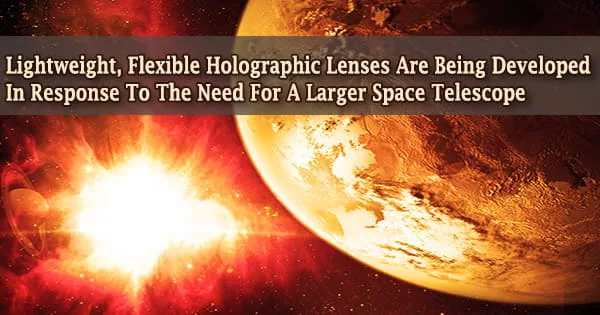A team of researchers is constructing holographic lenses that transform visible and infrared starlight into either a focused image or a spectrum, inspired by an idea for discovering exoplanets with a gigantic space telescope.
The approach, which was published in Nature Scientific Reports on Thursday, might be used to make a lightweight flexible lens with a diameter of many meters that could be rolled for launch and unfurled in space.
“We use two spherical waves of light to produce the hologram, which gives us fine control over the diffractive grating recorded on the film, and the effect it has on light either separating light with super sensitivity or focusing light with high resolution,” said Mei-Li Hsieh, a visiting researcher at Rensselaer Polytechnic Institute and an expert in optics and photonics who established a mathematical solution to govern the output of the hologram. “We believe this model could be useful in applications that require extremely high spectral resolution spectroscopy, such as analysis of exoplanets.”
Hsieh, who also teaches at National Yang Ming Chiao Tung University in Taiwain, collaborated with Thomas D. Ditto, an artist and inventor who invented the notion of an optical space telescope free of conventional, and heavy, glass mirrors and lenses. Ditto began working at Rensselaer in the 1970s and is now a visiting astrophysics researcher.
The weight and size of glass mirrors needed to focus light, which can realistically span only a few meters in diameter, limit telescopes that must be sent into space (to benefit from a view unobstructed by Earth’s atmosphere).
The lightweight flexible holographic lens used to focus light is referred as a “holographic optical element,” on the other hand, maybe dozens of meters across. According to Newberg, a Rensselaer professor of physics, applied physics, and astronomy, such an instrument might be used to directly see an exoplanet, a step forward from existing approaches that detect exoplanets based on their effect on light emanating from the star they orbit.
“To find Earth 2.0, we really want to see exoplanets by direct imaging we need to be able to look at the star and see the planet separate from the star. And for that, we need high resolution and a really big telescope,” said Newberg, an astrophysicist, and expert in galactic structure.
The holographic optical element is an improved Fresnel lens, which uses concentric rings of prisms distributed in a flat plane to simulate the focusing capabilities of a curved lens without the bulk.
To find Earth 2.0, we really want to see exoplanets by direct imaging we need to be able to look at the star and see the planet separate from the star. And for that, we need high resolution and a really big telescope.
Newberg
The Fresnel lens was invented for use in lighthouses in the nineteenth century, and today’s glass or plastic Fresnel lenses can be found in automotive lighting, micro-optics, and camera screens.
While Fresnel holographic optical components made by exposing a light-sensitive plastic film to two different sources of light at varying distances from the film are widespread, existing methods were limited to lenses that could only focus light rather than separate it into its constituent colors.
According to Lin, the corresponding author and a Rensselaer professor of physics, applied physics, and astronomy, the new technology allows the designers to either focus light onto a single point or scatter it into its constituent colors, providing a spectrum of pure colors.
The approach employs two light sources that are very close to one another and produce concentric waves of light that either build or cancel each other out as they go toward the film. The formulas discovered by Hsieh can be used to tune this pattern of convergence or interference.
It is printed, or “recorded,” as a holographic image on the film, and light traveling through the holographic optical element is either focused or stretched, depending on how the image is formed.
“We wanted to stretch the light so that we could separate it into different wavelengths. Any Fresnel lens will stretch the light a little, but not enough,” said Lin, an expert in photonic crystals and nano-photonics.
“With our method, we can have super-resolution on one end or super sensitive with each color separated. When the light is stretched like that, the color is very good, as pure and as vivid as you can get.”





